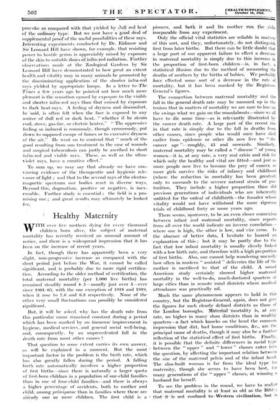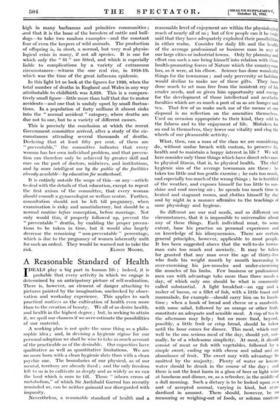Healthy Maternity
WITH over five mothers dying for every thousand children born alive, the subject of maternal mortality has recently received an unusual amount of notice, and there is a widespread impression that it has been on the increase of recent years. In fact, though there has apparently been a very slight, non-progressive increase as compared with the short period and before 'the War, it cannot be called significant, and is probably due to more rigid certifica- tion. According to the older -method' of certification, the total maternal mortality (per 1,000 live births) has remained steadily round 4---5--,--usually just over 5—ever since 1901-05, with the one exeeption of 1918 and 1919, when .it rose to 7.6 and 6.3 respectively. None of the other very small fluctuations can possibly be considered significant. But, it will be asked, why has the death rate from this particular cause remained constant during a period which has been marked by an ifinnense-inipinvement in hygiene, medical services, and general social well-being, and, consequently, by an unprecedented fall in the death rate from most other causes ?
That question to sonic extent carries its own answer, as will be explained in a moment. But the • most := important factor in the problem is the birth rate, which -, has also greatly fallen during the period. A- falling birth rate automatically involves a higher proportion of first births—since there is naturally a larger quota of first-born children in a population of one-child families than in one of four-child families--and there is always -, a higher percentage of accidents, both to mother and i child, among primiparae than in families where there are alandy one or more children. The first child is a pioneer, . and both it and' Its mother run the- _risks inseparable from any experiment. Only the official vital statistics are reliable in matters of this sort, and they, unfortunately, do not distinguish first from later births. But there can be little doubt that a large part of our apparent failure to effect a decrease in maternal mortality is simply due- to this increase in the proportion of first-born children—is, in fact, a statistical illusion due to the method of measuring the deaths of mothers by the births of babies.' We probably have effected some sort of a decrease in the rate of mortality, but it -has been masked by the Registrar- General's figures. The connection between maternal mortality and the fall in the general death rate may be summed up in the truism that in matters of mortality we are sure to lose on the swings what we gain on the roundabouts—since we all have to- die some time—as is- relevantly illustrated by the cancer death rate. A large part of the recent rise in that rate is simply due to the fall in deaths from other causes, since people who would once have died earlier from epidemic or other ills now live to' " the cancer age "—roughly, -45 and onwards. Similarly, maternal mortality may be called a " disease " of young women—it is, at any rate, a very real crisis and risk for which only the healthy and vital are fitted—and just as more people now live to become the prey of cancer, so more girls survive .the risks of infancy and childhood (where. the redUction in .mortality has been greatest) only to succumb to the severer natural strain of par- turition. They include a higher proportion than did previous generations of' individuals who are inherently unfitted for -the: ordeal of childbirth—the females- whose . • vitality would not have withstood the more rigorous trials of childhood forty or more- years ago. There seems,Aore' over, to bean even closer connexion between infant and maternal mortality, since reports from all over the world indicate an inverse correlation— where one is high, the other is low, and vice versa. In the absence of better data; I hesitate to hazard an explanation of- this ; but it may be partly due to the fact that low infant mortality is usually closely linked with a low birth-rate, and therefore with a high proportion of first births. Also, one cannot help wondering uneasily how often in modern " assisted " deliveries the life of the mother is sacrificed to that of the child. A sound American study certainly showed higher maternal mortality in the well-to-do, much-doctored quarters of large cities than in remote rural districts where medical attendance was practically nil. Much the same phenomenon appears to hold in this country, but the Registrar-General, again, does not give the figures for such clearly defined districts as those of the London boroughs; - Mfiterlial -mortality is, at any rate, no higher in many slum districts than in wealthy quarters—a fact -which knocks on the head the common impression that dirt, bad home conditions, &c., arc the principal cause of deaths, though it may also be a further reflection of the statistical effect of first births. Finally, it is possible that the definite differences in racial type between the " upper " and " lower " classes enter into the question, by affecting the important relation between the size of- the maternal pelvis and of the -infant head. The slim-built woman is far from the ideal type for maternity, though she seems . to have been - best, for many generations of the " upper " • elasses;- at winning husband for herself. To see the problem in the round, we have to realize that maternal mortality is at least "as old as the Bible ; that-it-is- not confined-to-Western -eivilizatieny --but is high in many barbarous and primitive communities ; and that it is the bane of the breeders of cattle and bull- dogs—to take two random examples—and the constant fear of even the keepers of wild animals. The production of offspring is, in short, a normal, but very real physio- logical crisis in many, if not all species.. It is one for which only the " fit" are fitted, and which is especially liable to complications by a variety of extraneous circumstances—witness the one real rise, in 1918-19, which was the time of the great influenza epidemic.
In this light let us look at the figures for 1930, when the total number of deaths in England and Wales in any way attributable to childbirth was 3,628. This is a compara- tively small figure—little more than half that due to motor accidents—and one that is unduly upset by small fluctua- . tions. In a population of forty millions it almost sinks into the " normal accident " category, where deaths are due not to one, but to a variety of different causes.
This is precisely the conclusion at which the recent Government committee arrived, after a study of the cir- cumstances attending several thousands of deaths. Declaring that at least fifty per cent. of them are " preventable," the committee indicates that every woman has her own individual problem, and that preven- tion can therefore only be achieved by greater skill and care on the part of doctors, midwives, and institutions, and by more intelligent use-by the public of the facilities already available—by education for motherhood.
It is entirely outside the scope of this—or any—article to deal with the details of that education, except to repeat the first axiom of the committee, that every woman should consult a gynaecologist or welfare centre. Further, consultation should not be left till pregnancy, when examination is risky and unsatisfactory, but should-be a normal routine before conception, before marriage. Not only would this, if properly followed • up, prevent the " preventable " deaths, by enabling the proper precau- tions to be taken in time, but it would also largely decrease the remaining " non-preventable " percentage, which is due to the pregnancy of women inherently unfit for such an ordeal. They would be warned not to take the



























































 Previous page
Previous page